
- Index
- Brand
- Anovos (6)
- Beskar (4)
- Disney (175)
- Disney Pixar (2)
- Efx Collectibles (11)
- Film-cell.co.uk (11)
- Funko (3)
- Générique (5)
- Icons (3)
- King Arts (6)
- Master Replicas (4)
- Mattel (2)
- Mauvais Genres (7)
- Neca (3)
- Poster (49)
- Taurus Studio (5)
- Tonner (4)
- Trooperbay (2)
- Walt Disney (11)
- Windlass Studios (4)
- Other (3693)
- Genre
- Industry
- Movie
- Aladdin (12)
- Alice In Wonderland (8)
- Beauty And The Beast (8)
- Brave (9)
- Encanto (5)
- Fantasia (11)
- Frozen (5)
- Hocus Pocus (6)
- Iron Man (5)
- Lilo & Stitch (5)
- Mandalorian (9)
- Mulan (5)
- Song Of The South (11)
- Star Wars (12)
- The Avengers (12)
- The Little Mermaid (12)
- Toy Story (10)
- Tron (6)
- Walt Disney (5)
- Wandavision (8)
- Other (3846)
- Object Type
- Size
1977 Israel DISNEY Movie FILM POSTER Hebrew HERBIE GOES To MONTE CARLO Jewish VR

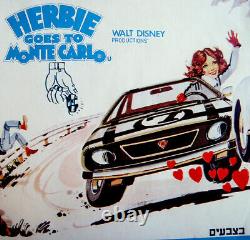
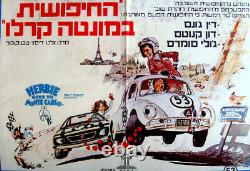
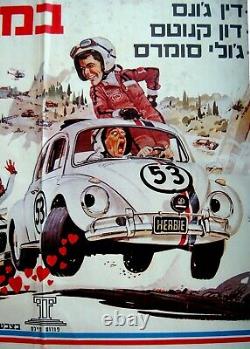
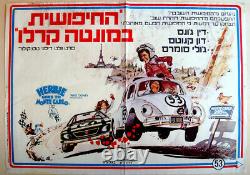

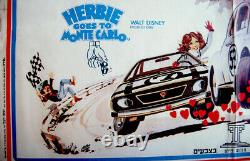


Here for sale is an ORIGINAL beautifuly illustrated colorful ISRAELI Theatre POSTER. The theatre poster which depicts an impressive IMAGE from WALT DISNEY 3rd film of the legendary HERBIE BEETLE " HERBIE GOES TO MONTE CARLO" , The third FILM in the LOVE BUG serie was issued in 1977 for the film.
By the Israeli distributers of the film. Kindly note : This is an ISRAELI MADE poster - Designed , Printed and distributed only in Israel. Size around 19" x 27" (Not accurate).
The poster is in quite good used condition. Should be very attractive framed behind a framed glass (Please watch the scan for a reliable AS IS scan). Poster will be sent rolled in a special protective rigid sealed tube. AUTHENTICITY : This poster is an ORIGINAL 1977 theatre poster , NOT a reproduction or a reprint , It holds life long GUARANTEE for its AUTHENTICITY and ORIGINALITY. Herbie Goes to Monte Carlo is a 1977 American comedy[2] adventure film[3] and the third installment of the The Love Bug film series made by Walt Disney Productions starring Herbiethe white 1963 Volkswagen racing Beetle with a mind of its own.
Contents 1 Plot 2 Cast 3 Promotion 3.1 Mann's Chinese Theatre 3.2 Novelization 3.3 Comic book 4 Reception 5 Home media 6 References 7 External links Plot[edit] Original car used during filming of Herbie Goes to Monte Carlo The film stars Dean Jones as returning champion race car driver Jim Douglas, joined by his somewhat cynical and eccentric riding mechanic Wheely Applegate (Don Knotts). Together with Herbie, the "Love Bug", a 1963 Volkswagen Beetle, they are participating in the fictional Trans-France Race, from Paris, France, to Monte Carlo, Monaco. According to dialogue, they hope to stage a racing comeback in the event. For the Trans-France Race, Douglas and Herbie have three major opponents.
The first is Bruno Von Stickle. (Eric Braeden), a German driver with experience in the "European Racing Circuit". He is deemed to be a formidable contender prior to and during the race. The second is Claude Gilbert (Mike Kulcsar), a French driver. His dominance in the race seemed similar to that of von Stickle, until he crashed in the later stages. The third is Diane Darcy (Julie Sommars), a very beautiful, if somewhat icy and feminist-minded, young American woman and the only female driver in the Trans-France Race. She initially hates Jim for apparently his, but what was actually Herbie's, knee-jerk behavior that ruined her chances of succeeding during the first qualifying rounds. This was because of Herbie sighting and falling in love at first sight with her race car.As being a car with whom Herbie falls in love during the film (much as Jim seems to be attracted to Diane herself), Herbie's infatuation with Diane's Lancia results in his compromising his full original plan of winning the Trans-France Race, and turning against that same will of his partners, Jim and Wheely. However, the strong-willed Diane does not appear to believe in any cars that can be alive and have a mind of their own. Diane and her Lancia unfortunately crash into a lake towards the end of the race, and with victory in sight. But Herbie and Jim manage to save both car and woman from drowning.
Because of this, she soon changes her attitude toward Jim after he saves her life and she witnesses Herbie towing her Lancia out of the lake. All three watch as Herbie crawls next to the Lancia and the two cars hold doors like holding hands. When Herbie seems to have trouble restarting because of being determined to stay with the Lancia, Diane is now fully convinced that cars can have minds of their own because she now knows her own car is alive as well. She encourages the little car not to relent in the quest for victory in the Trans-France Race. With Diane now out of the race (followed shortly thereafter by Claude Gilbert in the aforementioned crash), Jim pursues Von Stickle through the streets of Monte Carlo, combatants in a thrilling duel for the win.
In the end, though, Bruno von Stickle is overtaken by the little car in the famous tunnel of the Formula One race track, Herbie outracing him by outsmarting him through driving upside down on the tunnel roof. Jim drives Herbie to victory for (also according to dialogue) the 20th time in their careers. As the film progresses, two thieves, Max (Bernard Fox) and Quincey (Roy Kinnear), steal the famous Étoile de Joie (French for "Star of Joy") diamond and cleverly hide it in Herbie's fuel tank (Herbie was fitted with an external fuel filler cap for this film - a 1963 Beetle's cap actually being inside the front luggage compartment) in order to avoid being captured by a swarm of searching policemen.But little did they know that they picked the wrong car to hide it in, because of one car that was alive and had a mind of its own. That causes them to blow every chance they get in getting back the diamond they hid in him. Because of this, and on a count of an attempt where they at one point tried to threaten Jim and Wheely at gunpoint to relinquish the car to them, an encounter from which Herbie managed to escape, and thanks to a misunderstood conclusion thereafter that Diane would have tried to mastermind the whole event. Subsequently, Herbie is placed under the protection of the French police. It is also revealed not too far in that Inspector Bouchet (Jacques Marin), also known as "Double X" especially as a code name to the thieves, is the mastermind behind the museum robbery, though the fact of his scheme is revealed near the end of the movie.
It is the eager, and somewhat knee-jerk and unpunctual young detective Fontenoy (Xavier Saint-Macary), of whom the Inspector is the superior officer, who unravels the mystery of L'Étoile de Joie, and has Bouchet clapped in handcuffs. In the end, Jim and Diane begin to fall in love, as do Wheely and the Monte Carlo trophy girl (Katia Tchenko); even breaking a pact they made in the beginning. Most of all, Herbie and Giselle (Diane's Lancia) fall in love again as well. Cast[edit] Dean Jones as Jim Douglas Don Knotts as Wheely Applegate Julie Sommars as Diane Darcy Jacques Marin as Inspector Bouchet Roy Kinnear as Quincey Bernard Fox as Max Eric Braeden as Bruno von Stickle Xavier Saint-Macary as Detective Fontenoy François Lalande as Monsieur Ribeaux, the owner of the Museum "Étoile de Joie" Diamond. Alan Caillou as Emile, the Chief Monaco Official Laurie Main as Duval, the Museum Guard Mike Kulcsar as Claude Gilbert Johnny Haymer as Race official Stanley Brock as Taxi driver Gérard Jugnot as Waiter Jean-Marie Proslier as Doorman Tom McCorry as Showroom M.Lloyd Nelson as Mechanic Jean-Jacques Moreau as Truck driver Yveline Brière as Girl friend Sébastien Floche as French tourist Madeleine Damien as Old woman Alain Janey as Man at café Raoul Defosse as Police Captain Ed Marcus as Exhibit M. Richard Warlock, Gerald Brutsche, Kevin Johnston, Bob Harris, Carey Loftin, Jesse Wayne, Bill Erickson as The drivers Katia Tchenko as Monte Carlo trophy girl (uncredited) Josiane Balasko as Woman in the crowd (uncredited) André Penvern as French policeman (uncredited) Promotion[edit] Mann's Chinese Theatre[edit] On July 11, 1977, Herbie joined other immortals of the silver screen when he placed his wheel-prints in cement in the forecourt of Mann's Chinese Theatre in Hollywood, California; the ceremony was also attended by the film's stars Dean Jones, Don Knotts and Julie Sommars, as well as several hundred guests and tourists.
Mayor of Los Angeles Tom Bradley sent a proclamation officially declaring July 11 as "Herbie Goes to Monte Carlo Day" and a floral wreath was presented to Herbie by Miss Monte Carlo. The ceremony was preceded by a parade on Hollywood Boulevard featuring a traditional Chinese band, firecrackers, 25 Lancia sports cars, clowns, cheerleaders and the Goodyear Blimp. Afterwards, a special invitational screening of Herbie Goes to Monte Carlo was held inside the Chinese Theatre, which was celebrating its 50th anniversary that year. [4] Novelization[edit] Two different paperback novelizations of the film were published to coincide with the film's release: the US version was written by Vic Crume and published by Scholastic Paperbacks in June 1977; the UK version was written by John Harvey and published by New English Library for the film's UK release in 1978.
[5] Comic book[edit] A comic book of Herbie Goes to Monte Carlo (illustrated by Dan Spiegle) was featured in Walt Disney Showcase #41 published by Gold Key Comics. [6] On Metacritic the film has a weighted average score of 38 out of 100, based on 4 critics, indicating "generally unfavorable reviews". [7] Home media[edit] Herbie Goes to Monte Carlo was first released on VHS in 1982, early 1985 and re-released November 6, 1985 and September 16, 1997.
It was first released on DVD in Region 1 on May 4, 2004 and was re-released as a 2-DVD double feature set along with Herbie Rides Again on April 26, 2009. On September 2, 2012, Herbie Goes to Monte Carlo was re-released on DVD as part of Herbie: 4-Movie Collection with The Love Bug, Herbie Rides Again and Herbie Goes Bananas. On June 30, 2015, Herbie Goes to Monte Carlo was released on Blu-ray as a Disney Movie Club exclusive title. Herbie (sometimes referred to as "Herbie the Love Bug") is a fictional sentient anthropomorphic 1963 Volkswagen Beetle, a character that is featured in several Walt Disney motion pictures starting with the 1968 feature film The Love Bug.
He has a mind of his own and is capable of driving himself, and is often a serious contender in auto racing competitions. Throughout most of the franchise, Herbie is distinguished by red, white and blue racing stripes from front to back bumper, a racing-style number 53 on the front luggage compartment lid, doors, and engine lid, and a yellow-on-black'63 California license plate with the registration "OFP 857". Contents 1 History 2 Appearance in media 2.1 Film series 2.1.1 Box office performance 2.2 Television series 2.3 Other appearances 3 Guises and paint schemes 3.1 The Love Bug (1968) 3.2 Herbie Rides Again (1974) 3.3 Herbie Goes to Monte Carlo (1977) 3.4 Herbie Goes Bananas (1980) 3.5 The Love Bug (1997) 3.6 Herbie: Fully Loaded (2005) 4 References History[edit] This section describes a work or element of fiction in a primarily in-universe style. Please help rewrite it to explain the fiction more clearly and provide non-fictional perspective. (January 2019) (Learn how and when to remove this template message) Herbie's origins as a racing car are firmly established in The Love Bug (1968). Before the events of the film, he was bought from the showroom of Peter Thorndyke (David Tomlinson) by San Francisco socialite Mrs. Tennessee Steinmetz (Buddy Hackett), Jim's best friend and housemate, names the car "Herbie" after his uncle Herb, a middleweight boxer whose nose got shaped more and more like a Volkswagen Beetle, then makes Herbie a racing car.In Herbie Rides Again (1974), Herbie has been left to Tennessee's widowed aunt, Mrs. Steinmetz and her displaced neighbor, Nicole Harris (Stefanie Powers), try to save her house from being bulldozed by Alonzo Hawk (Keenan Wynn) with the help of Herbie. During the film, it is explained that after several successful races with Herbie, Douglas entered foreign racing circuits while his sidekick Tennessee is residing in Tibet to help his ailing instructor. During the film, it is revealed that Herbie has befriended other sentient VW Beetles and these team up with him to defeat Hawk, and we learn of the existence of other sentient objects (briefly mentioned by Tennessee in the first film), such as Mrs.
By Herbie Goes to Monte Carlo (1977), Douglas enters Herbie in the Trans-France Race and recruits mechanic friend Wheely Applegate (Don Knotts) to assist him. Herbie falls in love with a Lancia Scorpion named Giselle (who is also sentient, although Jim, Herbie and Wheely are the first to discover it) and Douglas with her driver Diane Darcy (Julie Sommars). Herbie also finds himself in the wrong place at the wrong time when the stolen Etoile de Joie diamond is hidden in his gas tank.
In Herbie Goes Bananas (1980), Douglas has retired from racing after Monte Carlo and leaves Herbie to his nephew, Pete Stancheck Stephen W. Burns, who plans to enter Herbie in the Brazil Grand Primeo. Having fallen into the ocean, Herbie is rescued by Paco and disguised as a taxi, later to stop a gang of con artists from stealing ancient Inca gold. Early in their partnership, Paco gives Herbie the nickname "Ocho" because he can't understand Herbie talking through his horn. Ocho is the Spanish word for the number 8; purportedly because the digits 5 and 3 in Herbie's racing number, 53, were combined to produce "8" (5+3 = 8) and possibly to rhyme with "Vocho", the Beetle's colloquial name in Mexico.After the Mexico debacle, Douglas takes in Herbie and opens a driving school in the TV series Herbie, the Love Bug. There, Douglas meets a woman named Susan MacLane and her three kids: Julie, Matthew, and Robbie, with the kids become friends to Herbie, But; however, a business man named Randy Bigelow want to get rid of Herbie and Douglas and get Susan back after they broke up during his wedding. Hank Cooper (Bruce Campbell) becomes the owner of Herbie in the 1997 made-for-television movie The Love Bug.
Here, Herbie's origins as a sentient Volkswagen Beetle are explained: an elderly German engineer named Dr. Gustav Stumpfel was building Herbie when a picture of his deceased wife fell into a vat of molten metal; with Stumpfel's love for her animating Herbie. During the film, Stumpfel is forced to build an evil Volkswagen counterpart to Herbie, "Horace the Hate Bug", from a sample of Herbie's original metal. Horace's personality is influenced by the narcissism of Herbie's former owner Simon when he has a picture of himself dropped into the metal vats, and kills Herbie during the film. Cooper buries Herbie, but the return of Jim Douglas sets Cooper to rebuild the fallen Love Bug with the help of the repentant Dr.Stumpfel and have him race against Simon and Horace. In this race, Herbie ultimately divides himself in half (as in the original film) to win the race. Over the years Herbie is passed down from owner to owner (including someone named "Maxx", who left his driver suit inside the hood), competing in many races, until he starts losing constantly to newer and faster cars, and later found by a tow truck driver in a garage and carried to Crazy Dave's scrapyard and, later, bought by Maggie Peyton (Lindsay Lohan) in Herbie: Fully Loaded (2005). He is later modified, becoming a 2002-cc-engined car and participating in various races, from a demolition derby to the final race of the Nextel Cup Series.
Herbie eventually falls in love with a Volkswagen New Beetle (which, at the end, is revealed to be a sentient car too). Appearance in media[edit] Herbie has been the central character of five theatrical-release films, a made-for-TV movie, and a short-lived television series.
Film series[edit] Occupation Film The Love Bug (1968) Herbie Rides Again (1974) Herbie Goes to Monte Carlo (1977) Herbie Goes Bananas (1980) The Love Bug (1997) Herbie: Fully Loaded (2005) Director Robert Stevenson Vincent McEveety Peyton Reed Angela Robinson Producer(s) Bill Walsh Ron Miller Kevin Corcoran Ron Miller Don Tait Joan Van Horn Irwin Marcus Robert Simonds Writer(s) Screenplay by Bill Walsh Don DaGradi Story by Gordon Buford Screenplay by Bill Walsh Story by Gordon Buford Arthur Alsberg Don Nelson Don Tait Ryan Rowe Screenplay by Thomas Lennon Robert Ben Garant Alfred Gough Miles Millar Story by Thomas Lennon Robert Ben Garant Mark Perez Composer George Bruns Frank De Vol Shirley Walker Mark Mothersbaugh Cinematography Edward Colman Frank Phillips Leonard J. South Frank Phillips Russ Alsobrook Greg Gardiner Editor(s) Cotton Warburton Gordon D.
Dean Jones reprised his role as Jim Douglas for the series. [3] Five episodes were made. [4] Other appearances[edit] In 1990, Herbie made an appearance in the second season of the 1980s revival of The Mickey Mouse Club. An animated version of Herbie made a brief cameo in two episodes of House of Mouse. Two racing video games starring Herbie were released by Disney Interactive Studios: Disney's Herbie: Fully Loaded (2005) and Disney's Herbie: Rescue Rally (2007).
Herbie used to make an appearance in the Lights, Motors, Action! Extreme Stunt Show at Disney theme parks, but was later replaced by Lightning McQueen.Herbie has had numerous appearances in Disney parades, and has taken part in Disney on Ice, and Disney on Parade, usually in the latter two with painted-on eyes and teeth, along with a moving tongue. This Herbie model has been moved to Disney's All-Star Movies Resort in Walt Disney World and is the centrepiece of'The Love Bug' themed area. Herbie has an unofficial appearance along with Maggie Peyton (portrayed by "Fully Loaded" actor Breckin Meyer) in a segment of Robot Chicken titled Horny Robot Redux.
In the segment, he is a New Beetle rather than an original Beetle and has animated eyes and a mouth. Herbie has a brief cameo in an episode of American Dad! Where he helps Stan Smith escape from poachers and wolves. In the episode, he has incorrect stripes and different 53 font. The Herbie film series spawned a knockoff series of Superbug films.
A white Beetle, split in half and numbered 53, makes a cameo in the first film of the series, though its name is never mentioned. Herbie had a cameo in The Simpsons episode "Beyond Blunderdome" in the Movie Car Museum. Herbie makes an appearance in Forza as a paint job for the 1960s Beetle Herbie appears in a Disneyland's 50th Anniversary TV commercial where he is used for transportation by Mickey and Goofy to get to Disneyland. Guises and paint schemes[edit] Herbie's appearance remained consistent throughout the first four film entries as well as the 1982 television series. There were only minor, subtle changes. The 1997 TV movie and Herbie: Fully Loaded featured major overhauls in Herbie's appearance, as there were different production crews working for Disney by this time.In order to create the effect of Herbie driving himself, Disney concocted a detailed system of sprockets and pulleys connected to a second steering column under the front seat for a rear seat driver. There was also a second set of pedal assemblies, clutch cables and a shifter extension. In The Love Bug, the rear seat driver sat low enough to see over the windshield but still out of the view of the camera. For Herbie Rides Again and Herbie Goes to Monte Carlo, Disney installed a hood-mounted Carello fog light that concealed a small camera which allowed the rear seat driver to view the street and sit lower.
[5] The Love Bug (1968)[edit] Original film car used in The Love Bug In the original film, The Love Bug, the original racing stripes differ from those in later movies; the stripes do not cover the valances or louvers of the car and the blue is a lighter shade. Also, Herbie features color-keyed running boards, while in later films the running boards are standard black. [6] During the film, depending on the scene, the wheels change from standard VW wheels (although fitted with plain hubcaps with no VW logo) to specially widened wheels on the racing Herbies. During one scene (when Tennessee is hanging out of the window), the "53" logo a. "Gumball" on the passenger-side door is missing. The door is also cut along the lower edge at an angle to enable the car to tilt over to the right on two wheels. [6] One of the modified racing Herbies featured a Porsche 356 engine, brakes and KONI shock absorbers.All Herbies in The Love Bug had the VW badges removed from the hood and featured plain non-VW hubcaps. The hood-mounted VW logo was replaced with a plain disc of the same diameter, colored to match the body. [6] Herbie Rides Again (1974)[edit] Fan-made Herbie replicas at Stamford Hall In Herbie Rides Again, Herbie features revised racing stripes, with the original blue switched to a dark navy.
In addition, the stripes were applied over the valances and louvers, and the front hood was recycled for 1982's television series Herbie the Matchmaker. Herbie also received a hood-mounted Carello fog light, and his running boards were now the more conventional black. [6] Additionally, Herbie was running on standard wheels yet again. Volkswagen also promoted the film by having a Type 1 Beetle, complete with Herbie livery, in every showroom.
There are various model errors in this film, such as the later "big window" (post-1964) Beetles being used. Also of note is the "cut-n-shut" engine cover after the warehouse break-in. The Beetle used was a late model, having a more bulbous flat-bottomed lid with an earlier rounded bottom edge welded on. After the success of The Love Bug, the film was heavily endorsed by Volkswagen, which was in financial trouble at the time, when Beetle sales in North America were considerably lower than in previous decades. As such, the company insisted that the VW logos appear on Herbie.
Both the hub cap VW logo and hood-mounted VW logo were reinstated at the company's request. Herbie Goes to Monte Carlo (1977)[edit] In Herbie Goes to Monte Carlo, Herbie is again fitted with wide racing wheels (Goodyear GT radials), and has an external fuel filler cap. Post-1967 Beetles did feature the fuel tank accessible on the right side behind the fender; the silver cap itself, however, was fake and added for the film's storyline. [7] With the addition of the fuel filler, the antenna is now a retractable unit fitted on the front cowling, near the windshield wipers. He has a roll cage again, and he has Monte Carlo racing stickers on his windows (one on the front window, two on the left back window, and one on the rear window).
Herbie still sports the hood-mounted Carello fog light with an added black cover sporting the company name. He now has gray bucket seats instead of stitched seats. Throughout this film, Herbie has an asymmetrical door mirror. There were a total of 9 VWs used in Herbie Goes to Monte Carlo.Many of these cars were recycled for use in Herbie Goes Bananas. [6] Herbie Goes Bananas (1980)[edit] In Herbie Goes Bananas, the hood-mounted light, the grey roll cage bar, the Monte Carlo racing stickers and the silver gas cap were removed. He still had his gray bucket seats, asymmetrical door mirror and his Goodyear GT Radial racing tires and rims, and Herbie's sunroof was the original light gray rather than the dark gray from Monte Carlo. The rust seen on the car in this film was painted on some of the Herbies.
The car that "walks the plank" in the movie was never recovered from the sea. It was tossed overboard from the M. The car is somewhere between La Paz and Baja California.
The car thrown overboard was not a proper car and had many wooden parts. Herbie Goes Bananas also featured the same later model door mirror as Herbie Goes to Monte Carlo.
Herbie set a Guinness World Record as the first car to go through the Panama Canal during filming in 1979. Herbie's name is only mentioned 3 times in the film by the garage owner, apart from the two times Herbie honks his horn at Paco trying to say his name when Paco couldn't understand what Herbie was saying. Some of these Herbie cars were recycled for Herbie, the Love Bug in 1982.
One of the actual film cars used with its flip wheel chassis in the bullfighting scenes now resides in Sydney, Australia. Another one was displayed in the Cars of the Stars Motor Museum until the museum's closure in 2011. Since then its new location remains unknown.
Volkswagen ceased the sale of Beetles in the USA one year before the film's release. 2005 Fully Loaded version of Herbie, specifically his "Street Race" look The Love Bug (1997)[edit] In The Love Bug television film there were some significant changes. The graphics used were copied from the 1974 Volkswagen of America decal kit, and the position on the front hood 53 was higher up.
The racing stripes were different sizes, and the shade of blue reverted to the lighter version used in the original 1968 movie. The sunroof was a solid white vs. Gray and was missing the racing stripes. Herbie's wheels were standard Beetle wheels, instead of the wider GoodYear GT Radial racing tires used in Herbie Goes to Monte Carlo and Herbie Goes Bananas, and the seats were regular instead of the gray bucket seats he had previously had. Herbie: Fully Loaded (2005)[edit] Herbie "personality car" preserved at Electric Dreams Slot Car in El Segundo, California.
This car remotely moves its eyes, bumper, hood, doors, visors, and antenna - giving it human-like characteristics. In Herbie: Fully Loaded, Herbie, who in this film seemed to be able to show emotions miming a face, went through several "costume changes" throughout the movie, changing his style dramatically from scene to scene. The font of the 53 is different, and it is slightly bigger and lower down on the front hood. The racing stripe is missing from the sunroof and the stripes are painted the way they were in the first four Herbie movies.Herbie's front licence plate is not present on his front bumper anymore. For the "street racer" look, Herbie has brighter white paint, a whale-tail rear spoiler, air intakes in the front of the rear fenders, lowered suspension, wider tires and a windowed rear engine cover through which blue LED lighting shows, No Vehicle Rear Bumper. He is also shown to have a nitrous oxide system to boost his speed during the race against Trip Murphy.
During the demolition derby, Herbie is stripped down with no vehicle interior panels, vehicle racing seats or special street racing body parts. The sunroof cover has been removed, although the cutout remains to play important roles during the demolition derby. He still retains the same 53 logos on the sides that he wore in his street race look except with Targets or Bullseyes Sprayed over the Logos and the white paint and all vehicular modifications in his Street Racer Version were all dismantled and completely thrown away for good. He later gets red Bull's-eye targets spray-painted on his front doors and hood by Crash. For the "NASCAR" look, Herbie gets a new, more off-white paint job, NASCAR sponsor decals, a different duck-tail rear spoiler, a roll cage, Goodyear Eagle NASCAR tires, wider fenders, and no more front turn signals or a back bumper or even a passenger seat and back seat. More than 30 different Herbies were used during the shooting of this film[6], and three original cars are known to be on display. There is one at the Volo Auto Museum[8] in Illinois and two other vehicles in California, one fully motorized is preserved at the Peterson Automotive Museum[9] and a personality car at the hobby store Electric Dreams[10]. Both California cars were used during the NASCAR racing segment of the film.The item "1977 Israel DISNEY Movie FILM POSTER Hebrew HERBIE GOES To MONTE CARLO Jewish VR" is in sale since Friday, June 4, 2021. This item is in the category "Entertainment Memorabilia\Movie Memorabilia\Posters\Originals-International\1970-79".
The seller is "judaica-bookstore" and is located in TEL AVIV. This item can be shipped worldwide.
- Size: Size around 19" x 27" ( Not accurate )
- Country/Region of Manufacture: Israel
- Original/Reproduction: Original
- Year: 1970-79
- Object Type: Poster
- Industry: Movies

